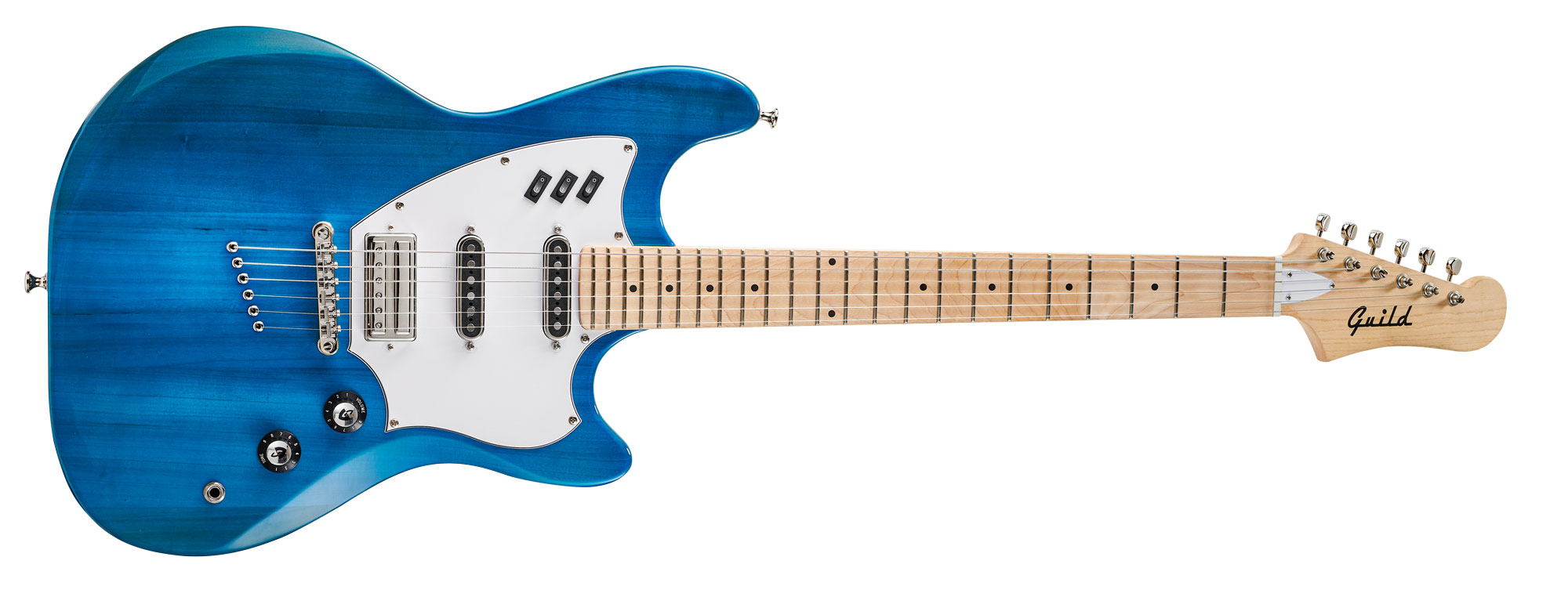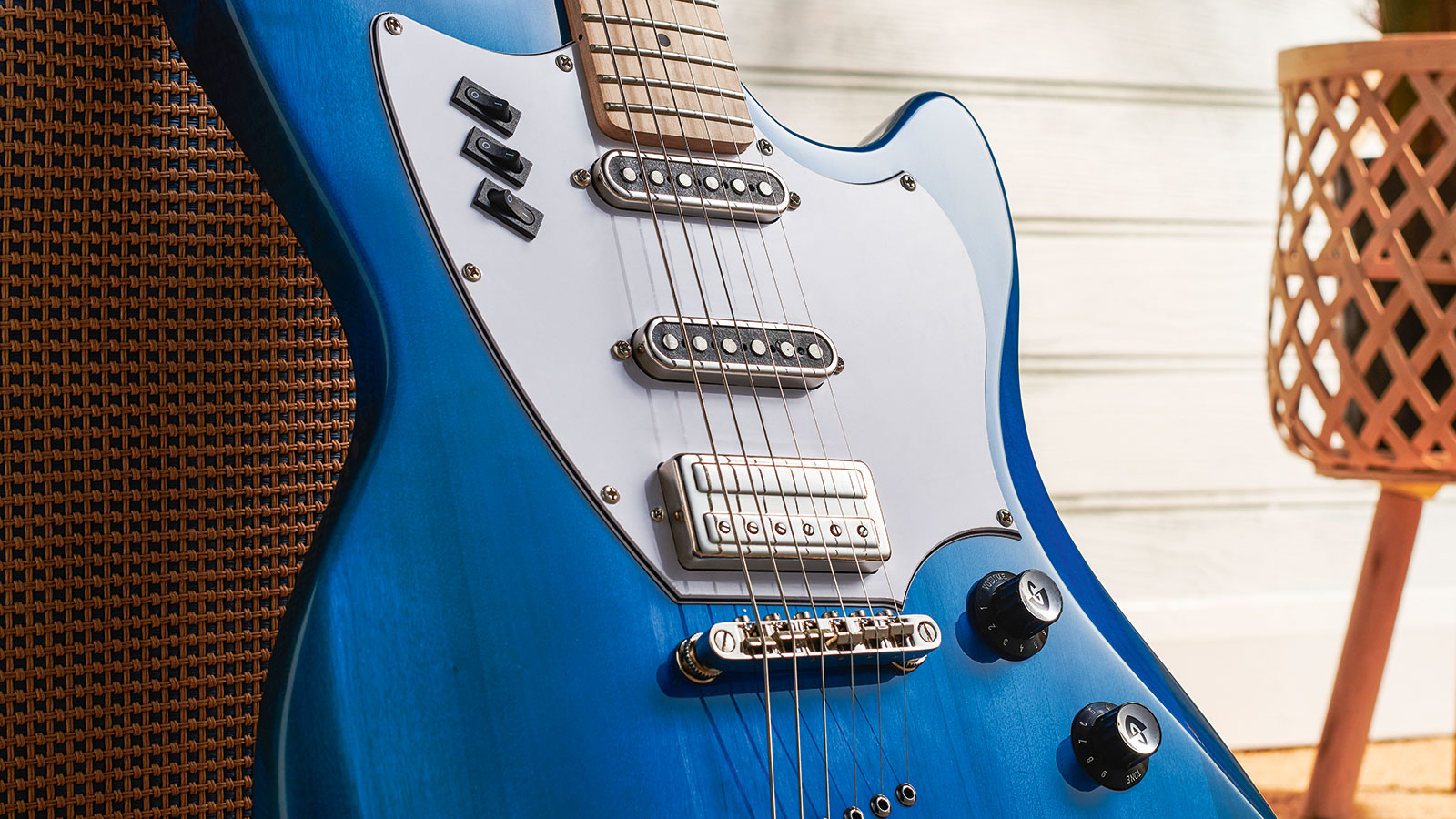Guitar World Verdict
This is a very affordable, lightweight and stable new solidbody design, and we have to say we’re swayed by the sounds.
Pros
- +
Price.
- +
Acceptable build quality.
- +
Lightweight, stable and resonant with some retro-y voices, notably the LB-1 bridge ’bucker.
Cons
- -
The on/off rocker switches aren’t as fast to use as a standard five-way selector, which could produce the same seven selections with a simple pull-switch.
- -
Our sample needed a little basic setup attention.
You can trust Guitar World
Presumably named after the Pacific Surfliner train service that runs down the California coast from San Luis Obispo to San Diego, this new electric is quite a departure for Guild.
First off, it undercuts the previous Newark St start-up model, the Jetstar, and is nearly half the price of the long-running S-100 Polara. It shares the Jetstar’s longer 648mm (25.5-inch) scale length but is the only bolt-on in the current range.
Guild did produce various bolt-ons to try to stay current in the 80s, but those were more ‘SuperStrat’-like; the style here seems more retro. And while technically an offset, as in its waist and curved bass-side base, the Surfliner doesn’t look – or feel – like any Guild guitar this writer has ever seen or played before.

“[It’s] an entirely new solidbody platform that crosses subtle offset styling with the vintage lines of 1960s and 1970s Guilds,” we’re told. Those horns look like they’ve come from the Jetstar, likewise the light chamfering on the top edges, plus we have a regular ribcage cut-out on the back. Through the translucent blue gloss finish (one of three offered) you can easily see the four pieces of poplar that make up the body spread, and there’s a little striped grain poking through, too.
The distinctive back-angled headstock is spliced on at the 2nd fret and is already featured on the Jetstar, along with the Starfire I Jet 90 – the only other three- pickup Guild electric in the current range – and apparently the Guild logo here is resurrected from the 1980s.

To be honest, the head looks a bit oversized, and that logo a little lonely on the expanse of plain maple, not helped by the bright white truss rod cover. Another oddity is that we have 23 frets – pretty unusual for any electric, old or new.
While the actual name might come from a train, the surf bit suggests a vibrato, which is missing here in favor of a tune-o-matic bridge and strings that pass through the body and are anchored in recessed ferrules on the back. It’s the sort of setup you see on much more progressive-style guitars (see the Manson ORYX, for example).
All the latest guitar news, interviews, lessons, reviews, deals and more, direct to your inbox!

The HSS pickup complement is more modern, too, even though Guild pairs its original small-footprint LB-1 humbucker (a design that dates back to the early 60s) at the bridge with two new-design DeArmond Aerosonic single coils in their partial metal covers. Because the tune-o-matic sits quite high on the body, all three pickups have to be raised some way from the scratchplate.
We’re on safer ground with the rear-mounted volume, tone and output jack, which are standard stuff, as are the ‘G’ logo Guild knobs, but the pickup selector switches throw another curveball.
These are neat little on/off ‘rocker’ switches, one for each pickup, and the sort of thing you might see on a modern table lamp. As well as the ability to completely mute the guitar you get the standard Strat-like selections, plus bridge and neck and all-three together – seven combinations in total.
Feel & Sounds
The slightly oddball design elements don’t distract from a guitar that is light in weight, hangs well on a strap and feels more than comfortable seated. The heel position and that treble cutaway allow easy access to the upper frets, and it doesn’t feel too bad at all out of the box, though it does ship with 0.011-gauge strings, which simply might be too tough for its target audience.
The 254mm (10-inch) ’board radius is the same as PRS, marginally flatter than modern Fender, and sports ‘narrow jumbo’ frets, which aren’t either, particularly, measuring approximately 2.7mm wide by 1.1mm high.
It can certainly jangle on clean amp tones and has enough clarity to work very well with a pedalboard, but it also works very well with fuzzier gains
They could do with a bit of a polish to avoid that slightly scratchy feeling as you bend, and the string slots are left a little high on the Gibson-style composite nut. It certainly doesn’t match the smart detail of PRS’s SE Silver Sky – which also sports a poplar body – but then again without a gigbag it does cost over 50 per cent less.
The neck shape might be classed by Guild as a ‘C’, but it feels fuller in the hand than the dimensions suggest (the 1st fret depth is 20.5mm and it’s 23.4mm at the 12th, with a 42.6mm nut width) as the shoulders feel pretty big and there’s a slightly flatter back.
Now, we could carp about the relatively minor setup issues, or we could fix ’em with some 20 minutes’ work. For example, there’s an unnecessary neck shim that, when removed, means we can sit the tune-o-matic (and pickups) lower. The nut slots simply need to be lowered, and both the 2nd and 4th frets are slightly high on the treble side, again a simple job to spot-level, reprofile and buff up.

Sonically, what do you think a guitar like this will sound like? You’re right, a Fender! While not every Guild aficionado enjoys the LB-1 bridge pickup, here it’s very well matched both in output and style; it’s a lighter, brighter ’bucker, for sure, with a gritty edge but one that provides some welcome girth.
It can certainly jangle on clean amp tones and has enough clarity to work very well with a pedalboard, but it also works very well with fuzzier gains that you can easily file under late ‘60s Stones-y garage-rock. It also plays well with the Aerosonics, which might have a slightly too- crisp edge and relatively trimmed low-end – but, again, they sound pretty authentic if you’re chasing more retro single-coil voices.
However, the rocker switch idea is nowhere near as fast to use as a good ol’ five-way lever switch, which we’d prefer with a simple pull-switch on the tone to achieve the ‘seven sound’ mod.
As it is, to move from neck and middle combined to bridge you have to mute each of the single coils then switch on the bridge pickup. And, c’mon, any guitar that you can accidentally totally mute in the heat of battle is a no-no for any gigging musician, isn’t it?

Verdict
Clearly an attempt to broaden the audience for its electric guitars in both style and price, this now start-up Surfliner is going to polarize opinion. It’s all a little oddball but somehow manages to come together to produce some good Fender-based old-school sounds, which certainly match the ‘was it designed in the past?’ vibe.
While our sample did need a little tweaking, and we have to question what exactly those mini-rocker switches are bringing to the table, particularly for the gigging musician. Something a little different? Definitely.
Specs
- PRICE: $ / £395
- ORIGIN: Indonesia
- TYPE: Offset double-cutaway solidbody
- BODY: Poplar
- NECK: Maple, ‘C’ profile, bolt-on
- SCALE LENGTH: 648mm (25.5”)
- NUT/WIDTH: Composite/42.6mm
- FINGERBOARD: Maple, black dots (5mm), 254mm (10”) radius
- FRETS: 23, narrow jumbo
- HARDWARE: Guild tune-o-matic bridge with through-body stringing, Kluson-style vintage tuners – chrome/nickel plated
- STRING SPACING, BRIDGE: 51.5mm
- ELECTRICS: Guild LB-1 humbucker (bridge), 2x DeArmond Aerosonic single coils (middle/neck), 3x on/ off pickup selector ‘rocker’ switches, master volume and tone controls WEIGHT (kg/lb): 3.06/6.73
- OPTIONS: No
- RANGE OPTIONS: The Newark St electrics above the Surfliner start with the Jetstar
- LEFT-HANDERS: No
- FINISHES: Catalina Blue (as reviewed), White Sage, Sunset Orange – gloss body, satin neck
- CONTACT: Guild

Dave Burrluck is one of the world’s most experienced guitar journalists, who started writing back in the '80s for International Musician and Recording World, co-founded The Guitar Magazine and has been the Gear Reviews Editor of Guitarist magazine for the past two decades. Along the way, Dave has been the sole author of The PRS Guitar Book and The Player's Guide to Guitar Maintenance as well as contributing to numerous other books on the electric guitar. Dave is an active gigging and recording musician and still finds time to make, repair and mod guitars, not least for Guitarist’s The Mod Squad.

